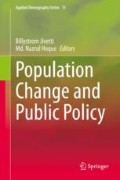Abstract
Being a woman in a patriarchic society has labor market cost due to institutional discrimination. It does not only imply in terms of the sex earnings ratio but has a significant impact on the long-term economic development. Using the 2011–12 National Sample Survey (NSS) data, this study analyzes gender inequality in earnings across different socioreligious groups in India. We appoint two different techniques of earnings gap decomposition: a parametric, and a matching-based non-parametric decomposition. Both methods confirm an active role of gender discrimination in the Indian labor market. Specifically, the non-parametric technique suggests that most of the earning gaps are due to gender discrimination. The parametric method additionally suggests that gender discrimination in socially vulnerable castes (e.g., tribes and scheduled castes) are far less than that in other socioreligious groups. The matching-based decomposition allows us to conclude that men workers, irrespective of castes, have some advantageous labor market characteristics through the historical practice of patriarchal favoritism. Findings of this study call for the promotion of gender empowerment through government policies on equity and justice.
Access this chapter
Tax calculation will be finalised at checkout
Purchases are for personal use only
References
Barsky, R., Bound, J., Charles, K. K., & Lupton, J. P. (2002). Accounting for the black–white wealth gap: A nonparametric approach. Journal of the American Statistical Association, 97(459), 663–673.
Becker, G. S. (1957). The economics of discrimination. Chicago: University of Chicago Press.
Becker, G. S. (1962). Investment in human capital: A theoretical analysis. Journal of Political Economy, 70(5, Part 2), 9–49.
Bielby, W. T., & Baron, J. N. (1986). Men and women at work: Sex segregation and statistical discrimination. American Journal of Sociology, 91(4), 759–799.
Blinder, A. S. (1973). Wage discrimination: Reduced form and structural estimates. Journal of Human Resources, 84, 436–455.
Chakraborty, S. (2016). Occupational sex segregation: An inquiry into Indian Job Market. Journal of Regional Development and Planning, 5(2), 1.
Chattopadhyay, M., Chakraborty, S., & Anker, R. (2013). Sex segregation in India’s formal manufacturing sector. International Labour Review, 152(1), 43–58.
DiNardo, J., Fortin, N. M., & Lemieux, T. (1996). Labor market institutions and the distribution of wages, 1973-1992: A semiparametric approach. Econometrica, 64(5), 1001–1044.
Donald, S. G., Green, D. A., & Paarsch, H. J. (2000). Differences in wage distributions between Canada and the United States: An application of a flexible estimator of distribution functions in the presence of covariates. The Review of Economic Studies, 67(4), 609–633.
Hartmann, H. (1976). Capitalism, patriarchy, and job segregation by sex. Signs: Journal of Women in Culture and Society, 1(3, Part 2), 137–169.
Heckman, J. J., & Todd, P. E. (2009). A note on adapting propensity score matching and selection models to choice based samples. The Econometrics Journal, 12(suppl_1), S230–S234.
Heckman, J. J., Ichimura, H., & Todd, P. E. (1997). Matching as an econometric evaluation estimator: Evidence from evaluating a job training programme. The Review of Economic Studies, 64(4), 605–654.
Karki, M., & Bohara, A. K. (2014). Evidence of earnings inequality based on caste in Nepal. The Developing Economies, 52(3), 262–286.
Mincer, J. (1974). Schooling, experience, and earnings. Human behavior & social institutions No. 2. National Bureau of Economic Research (NBER). New York.
Mincer, J., & Polachek, S. (1974). Family investments in human capital: Earnings of women. Journal of Political Economy, 82(2, Part 2), S76–S108.
Mukherjee, D., & Majumder, R. (2011). Occupational pattern, wage rates and earning disparities in India: A decomposition analysis. Indian Economic Review, 46, 131–152.
Ñopo, H. (2008). Matching as a tool to decompose wage gaps. The Review of Economics and Statistics, 90(2), 290–299.
Oaxaca, R. (1973). Male-female wage differentials in urban labor markets. International Economic Review, 14, 693–709.
Reskin, B. (1993). Sex segregation in the workplace. Annual Review of Sociology, 19(1), 241–270.
Rosenbaum, P. R., & Rubin, D. B. (1983). The central role of the propensity score in observational studies for causal effects. Biometrika, 70(1), 41–55.
Schultz, T. W. (1961). Investment in human capital. The American Economic Review, 51, 1–17.
Uppal, A. (2007). Gender discrimination in quality of employment and wages in unorganized manufacturing sector of India. Paper presented in gender issues and Empowerment of Women Platinum Jubilee of Indian Statistical Institute, 1–2 February 2007.
Acknowledgments
The authors like to acknowledge Professor Guillermina Jasso for the Student Paper Award at 2019 Biennial Population and Public Policy Conference. We also wish to thank Dr. Amanda Kerr, Dr. Soumi R. Chowdhury, and Dr. Kira Villa for their valuable feedback toward the first draft of the manuscript. Our sincere thanks to the anonymous reviewer whose comments and suggestions have significantly improved the manuscript. Finally, we extend our thanks to two small funding- J. Raymond Stuart Award in Economics, and Graduate & Professional Student Association (GPSA) Student Research Grant for the data purchase and conference participations.
Author information
Authors and Affiliations
Corresponding author
Editor information
Editors and Affiliations
Additional information
Disclaimer: The original article entitled “Working and Getting Paid, But Eventually Less Than Men: By How Much in India?” by Soumyajit Chakraborty, Alok K. Bohara, Melissa Binder, and Richard Santos is being submitted exclusively to the International Association of Applied Demography for publication consideration into an edited book titled “Population Change and Public Policy” by Springer International Publishing.
Rights and permissions
Copyright information
© 2020 The Editor(s) (if applicable) and The Author(s), under exclusive license to Springer Nature Switzerland AG
About this chapter
Cite this chapter
Chakraborty, S., Bohara, A.K., Binder, M., Santos, R. (2020). Is the Indian Labor Market Biased Against Women? Yes!. In: Jivetti, B., Hoque, M.N. (eds) Population Change and Public Policy. Applied Demography Series, vol 11. Springer, Cham. https://doi.org/10.1007/978-3-030-57069-9_11
Download citation
DOI: https://doi.org/10.1007/978-3-030-57069-9_11
Published:
Publisher Name: Springer, Cham
Print ISBN: 978-3-030-57068-2
Online ISBN: 978-3-030-57069-9
eBook Packages: HistoryHistory (R0)

